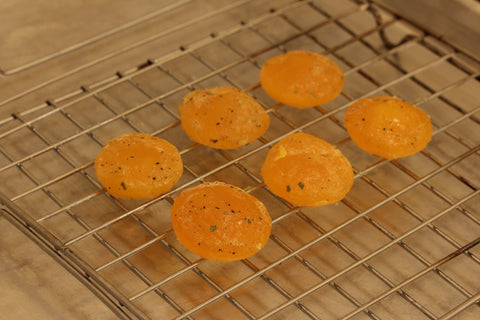I get a lot of people asking me to post dairy free options/substitutes, so here’s a little ace up the sleeve of high end restaurant chefs who want to give you that dairy free ‘wow’ factor. Curing. It is a great way to take humble ingredients, and turn them into something amazing. Curing egg yolks is an easy one, and you can reap your rewards in only four days, and you can't say that for most cured foods. Essentially, you are adding equal parts of salt and sugar, and then whatever aromatics you choose. You are creating a hard cheese like puck, that is similar in flavour to that of a Parmesan cheese, minus the dairy. It is large in umami, salty character and is great for finishing pastas, salads, soups, or anything that you want to add a salty, rich kick to. I first came across this at restaurant Meadowood, in St. Helena, California. One of the perks of working for the Relais and Chateau group was getting to stay at these properties and try some of these amazing restaurants. In the write up below I will give you the step by step of the process of curing egg yolks. You can use as little as just salt and sugar, but I feel like the other ingredients are really what take it over the top.
Ingredients needed; Salt, sugar, egg yolks, thyme, bay leaves, bonito flakes (optional)-gives it a nice little accenting smokey note

I prefer using about 60/40 salt to sugar, you can also go half and half, it just depends on personal preference here. Because I am looking for a nice salty kick to replace Parmesan cheese for pastas and salads, I will use slightly more salt than sugar. If I were grating this overtop of a dessert, I would use a 50/50 blend and omit all of the aromatics.
Step 1 - Process your salt, sugar, and aromatics


Start by placing 60% salt to 40% sugar into a food processor, followed by your chosen aromatics. In this case we chose, bay leaf and thyme (to give it a nice herbacious character), and bonito flakes (a nice smokey note). The amount of salt and sugar you use depends on how many egg yolks you plan on curing.

Step 2 - Pour a layer of the salt mixture into a non-reactive dish

It is best to use a glass container of sorts, as it will not react with the curing process. Pour about an inch of the salt mixture in to fully cover the bottom of the container, and spread it out flat.
Step 3 - Make as many indentations as yolks you are curing

By using the bottom of the whole egg, make as many indentations as yolks you are curing, just big enough for a yolk to sit in.
Step 4 - Place your yolks into the indents

Be careful when you are breaking the eggs and seperating the whites from the yolks that you don't nick the yolk, as you want to end up with perfect little cured rounds.

Step 5 - Cover the yolks with the remaining salt mixture

Start by using a sifter, to gently sift the salt mixture on top of the egg yolks. Once they are slightly covered, finish by pouring the remaining salt mixture over the yolks.
Step 6 - Make an indent with your finger so that you know here each yolk is

This is important, especially if you are doing a larger batch, as you want to know exactly where each yolk is buried, so that you can gently retrieve them.
Step 7 - Transfer to the fridge

Wrap the container in saran wrap and transfer to the fridge for 4 days.
Step 8 - Remove from the fridge


Remove the egg yolks from the fridge after 4 days. You will notice how much moisture the salt mixture has pulled, as it will be very damp.
Step 9 - Remove the yolks from the salt


Gently remove the little egg yolk pucks from the salt, they will be hard, but still delicate at this point. Using a pastry brush, take off as much of the salt as possible without disrupting the yolk.
Step 10 - Rinse off the yolks


Rinse the yolks to get the majority of the remaining salt off, and then pat dry using paper towels.
Step 11 - Place the dry yolks onto a baking rack then into the oven/dehydrator

Place the yolks onto a lightly greased baking rack (a neutral oil, grape seed is best, canola/vegetable oil is just fine) that is lying on top of a sheet pan. You are now going to transfer these into the dehydrator (or an oven that goes as low as 150 degrees) for 2 hours. If your oven only goes down to 200 degrees, cook them only for 40 minutes. And if you have an old school oven that only goes down to 240, set it as low as it goes, and use a cork (real cork, not plastic) to hold the door ajar a little so that air can get in (you won’t need any more than 40 minutes with this method).
Step 12 - Remove from the oven/dehydrator

When you remove the yolks from the oven, they should be slightly translucent and look like little apricots.
Step 13 - Transfer yolks to an airtight container
Transfer the yolks to an airtight container and refrigerate for up to a month.
Step 14 - Use as a finishing garnish

Using a microplane, grate the egg yolk over top the finished dish. Use in place of Parmesan cheese, as a dairy free alternative, or anywhere you want to add a hint of rich, nuttiness, with a nice pop of yellow. In restaurants we would use this over dishes like steak tartar or caviar dishes, but I think where it excels is elevating more humble dishes, like finishing a pasta, a salad, or on vegetables, like some simply sautéed wild mushrooms or asparagus. The options are absolutely endless.

https://diamondlnwpg168.com/
https://www.paiklangna.com/
https://br.advfn.com/forum/perfil/bluezardriri9
https://scrapbox.io/noneyseo1/NonneySeo
https://cara.app/noney168/all
https://www.bitsdujour.com/profiles/aCQrfW
https://yesilkartforum.com/forum/user/noney1688
https://forum.lexulous.com/user/bluezardriri
https://popl.co/profile/KJdIwsLe/dash
https://github.com/Programming-from-A-to-Z/A2Z-F15/issues/30
https://github.com/defunkt/ambitious_activeldap/issues/14
https://github.com/openai/sparse_attention/issues/13
https://github.com/dashpradeep99/https-github.com-miguellgt-books/issues/6
https://github.com/HoyDiamond/DiamondSeo01/issues/1
https://github.com/cy4nguy/PythonSimpleKeylogger/issues/3
https://github.com/gzc/isystem/issues/1
https://github.com/SaeruHikari/SakuraEngine-Old/issues/3
https://github.com/xyba1337/ValorantEZTS/issues/3
https://github.com/henryjeff/portfolio-website/issues/16
https://github.com/EllanJiang/GameFramework/issues/76
https://github.com/HoyDiamond/DiamondSeo01/issues/2
https://github.com/qianjiahao/MongoDB/issues/2
https://github.com/u21h2/nacs/issues/13
https://github.com/Programming-from-A-to-Z/A2Z-F15/issues/31
https://github.com/qw3rtman/p/issues/35
https://github.com/Pleumpi1688/Kittichaiya1680/discussions/1
https://github.com/bitsandbytes-foundation/bitsandbytes/discussions/1631
https://github.com/rafaballerini/GitTutorial/issues/200
https://github.com/Yalantis/uCrop/issues/948
https://github.com/kaina134556666666666/kaina123/issues/1
https://github.com/Thanaratchaku/Thammapak-/issues/1
https://github.com/Reongsamai/Pipattanakul/issues/1
https://github.com/Jarassopon/Chartpipak-/issues/1
https://github.com/Prommabuth/Srisarawong/issues/1
https://github.com/Thammapak/Srisawatwongchai-/issues/1
https://github.com/Gongkiatsakul/Pichitcharoenwong-/issues/1
https://github.com/Narinchanok/Anansapcharoen/issues/1
https://github.com/Panichvattanaku/Pichitcharoenwong-/issues/1
https://github.com/Vichayaprasertkul/Siripapan/issues/1
https://github.com/Nitithamrong/Rattanaprasert/issues/1
https://github.com/Rattanaprasit22/Udomsawatdisuk-/issues/1
https://github.com/Chakraphanpradit/Kajornsakkoso/issues/1
https://github.com/Gongkiatsakul/Pichitcharoenwong-/issues/1
https://github.com/Narinchanok/Anansapcharoen/issues/1
https://github.com/Panichvattanaku/Pichitcharoenwong-/issues/1
https://github.com/Vichayaprasertkul/Siripapan/issues/1
https://github.com/Nitithamrong/Rattanaprasert/issues/1
https://github.com/Rattanaprasit22/Udomsawatdisuk-/issues/1
https://github.com/Chakraphanpradit/Kajornsakkoso/issues/1
https://github.com/Wiwatthanasak/Ronnaporn-/issues/1
https://github.com/Supannapakin/Chompunut-/issues/1
https://github.com/antaraprasert/Patanapreecha-/issues/1
https://github.com/Patamadecha/Nichakarn-/issues/1
https://github.com/Jeerawongsa/Kiatwittaya-/issues/1
https://github.com/Bannawan/Weerachai-/issues/1
http://diamondlnwpg168.com/
https://paiklangna.com/
http://diamondlnwpg168.com/
https://paiklangna.com/
https://github.com/11DIAMOND168/Mac/issues/1
https://github.com/22DIAMOND168/Mack/issues/1
https://github.com/DIAMOND168MM/Mac/issues/1
https://github.com/DIAMOND168MM/Mac/issues/1
https://github.com/DAMDAMme11225566/Natoo/issues/1
https://github.com/MAVKMAVK11111111111142/Mack1259/issues/1
https://github.com/sggsdfsdfdsfds6745123/NAgoo168/issues/1
https://github.com/Lertkoonawong/Chartsombat111/issues/1
https://github.com/Prasanwong/Intaraprasart/issues/1
https://github.com/Rattanaprasert/Sangsawang111/issues/1
https://github.com/Narinchanok/Suwanwechatada111/issues/1
https://github.com/Suwankaruna/Dechaboon111/issues/2
https://github.com/Pitijamroen/Rattanaprasert111/issues/1
https://github.com/Roongrudee44/Kwankaew111/issues/1
https://github.com/4DIAMOND168/Phan/issues/1
https://github.com/5DIAMOND168/May/issues/1
https://github.com/3DIAMOND168/Muay/issues/1
https://github.com/6DIAMOND168/Mack/issues/1
https://github.com/2DIAMOND168/Mack/issues/1
https://github.com/1DIAMOND168/Mack/issues/1
https://github.com/12DIAMOND168/Mack/issues/1
https://github.com/16DIAMOND168/Mack/issues/1
https://github.com/8DIAMOND168/Mack/issues/1
https://github.com/7DIAMOND168/Mack1/issues/1
https://github.com/DIAMOND168N/Mavk/issues/1
https://github.com/kaina134556666666666/kaina123/issues/1
https://github.com/Thanaratchaku/Thammapak-/issues/1
https://github.com/Reongsamai/Pipattanakul/issues/1
https://github.com/Jarassopon/Chartpipak-/issues/1
https://github.com/Prommabuth/Srisarawong/issues/1
https://github.com/Thammapak/Srisawatwongchai-/issues/1
https://github.com/Gongkiatsakul/Pichitcharoenwong-/issues/1
https://github.com/Narinchanok/Anansapcharoen/issues/1
https://github.com/Panichvattanaku/Pichitcharoenwong-/issues/1
https://github.com/Vichayaprasertkul/Siripapan/issues/1
https://github.com/Nitithamrong/Rattanaprasert/issues/1
https://github.com/Rattanaprasit22/Udomsawatdisuk-/issues/1
https://github.com/Chakraphanpradit/Kajornsakkoso/issues/1
https://github.com/Gongkiatsakul/Pichitcharoenwong-/issues/1
https://github.com/Narinchanok/Anansapcharoen/issues/1
https://github.com/Panichvattanaku/Pichitcharoenwong-/issues/1
https://github.com/Vichayaprasertkul/Siripapan/issues/1
https://github.com/Nitithamrong/Rattanaprasert/issues/1
https://github.com/Rattanaprasit22/Udomsawatdisuk-/issues/1
https://github.com/Chakraphanpradit/Kajornsakkoso/issues/1
https://github.com/Wiwatthanasak/Ronnaporn-/issues/1
https://github.com/Supannapakin/Chompunut-/issues/1
https://github.com/antaraprasert/Patanapreecha-/issues/1
https://github.com/Patamadecha/Nichakarn-/issues/1
https://github.com/Jeerawongsa/Kiatwittaya-/issues/1
https://github.com/Bannawan/Weerachai-/issues/1
http://diamondlnwpg168.com/
https://paiklangna.com/
https://diamondlnwpg168.com/
https://www.paiklangna.com/
https://br.advfn.com/forum/perfil/bluezardriri9
https://scrapbox.io/noneyseo1/NonneySeo
https://cara.app/noney168/all
https://www.bitsdujour.com/profiles/aCQrfW
https://yesilkartforum.com/forum/user/noney1688
https://forum.lexulous.com/user/bluezardriri
https://popl.co/profile/KJdIwsLe/dash
https://github.com/Programming-from-A-to-Z/A2Z-F15/issues/30
https://github.com/defunkt/ambitious_activeldap/issues/14
https://github.com/openai/sparse_attention/issues/13
https://github.com/dashpradeep99/https-github.com-miguellgt-books/issues/6
https://github.com/HoyDiamond/DiamondSeo01/issues/1
https://github.com/cy4nguy/PythonSimpleKeylogger/issues/3
https://github.com/gzc/isystem/issues/1
https://github.com/SaeruHikari/SakuraEngine-Old/issues/3
https://github.com/xyba1337/ValorantEZTS/issues/3
https://github.com/henryjeff/portfolio-website/issues/16
https://github.com/EllanJiang/GameFramework/issues/76
https://github.com/HoyDiamond/DiamondSeo01/issues/2
https://github.com/qianjiahao/MongoDB/issues/2
https://github.com/u21h2/nacs/issues/13
https://github.com/Programming-from-A-to-Z/A2Z-F15/issues/31
https://github.com/qw3rtman/p/issues/35
https://github.com/Pleumpi1688/Kittichaiya1680/discussions/1
https://github.com/bitsandbytes-foundation/bitsandbytes/discussions/1631
https://github.com/rafaballerini/GitTutorial/issues/200
https://github.com/Yalantis/uCrop/issues/948
Leave a comment